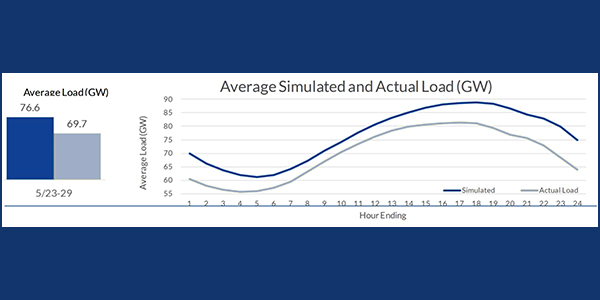Unseasonably warm weather has nudged MISO load a little closer to normal this week, though RTO officials say demand is still being compressed by pandemic-related social distancing measures.
A heat wave pushed MISO’s peak load to nearly 100 GW, compared with peaks of about 73.5 GW in April and May.
“Our peak has been around 75 GW, and since we’ve seen warmer temperatures, our load jumped up 25,000 MW to about 100 GW, so things have been changing quickly,” MISO Executive Director of Real-Time Operations Rob Benbow said during a Reliability Subcommittee meeting Thursday.
Last June saw a peak of 107.8 GW late in the month, with loads averaging 77.8 GW, far below the 84.5-GW average in June 2018.
But Benbow said MISO load has not quite returned to normal.
“I think we’re still seeing some impacts of COVID on our load right now,” Benbow said.
MISO predicts a 125-GW summer peak, with 152 GW of capacity on hand to cover it before generation outages are factored in.
Director of Balancing and Interchange Operations Tag Short said MISO will probably have to declare an emergency this summer to access load-modifying resources to mitigate tight supply. (See MISO Preps for Balmy Summer with Pandemic Effects.)
“And, oh by the way, NOAA is forecasting a warmer-than-average summer for the entire footprint. Seems like that happens every year,” Short reported.
But Short said MISO’s summertime load predictions, first presented in April, don’t consider the pandemic continuing to shave some megawatts off load through the season. At last count, load was trending about 10% below average in May.
“Today, systemwide demand is slightly down because of the pandemic. In the case that energy usage does remain low, it may get us through July and August without a maximum generation alert,” Short said.
Some stakeholders chafed at MISO not factoring in the pandemic in its summer readiness presentations.
“When MISO makes these very public declarations, it has consequences. My executive is going to come to me asking for our preparations; my regulator is going to come to me asking for our plans. If this is really nothing more than Chicken Little saying, ‘the sky is falling,’ then it’s going to waste a lot of time,” Consumers Energy’s Kevin Van Oirschot said.
MISO also began to gradually phase in the return of its employees to work on Monday, Benbow said, allowing some non-operator positions to work on-site in its buildings on a voluntary basis.
Benbow said employees that wish to return must first answer screening questions via a phone app that instructs them on whether entering the office is advisable.
Employees must don a mask whenever they’re not at their personal workstations, Benbow said.
“We have seen a dozen people really come and go throughout the week. We didn’t expect a lot of people to return, and we’re still encouraging people to work from home,” Benbow said.
RSC Chair Bill SeDoris, of Northern Indiana Public Service Co., said his company has rolled out similar measures.
“It seems like this is going to be a common practice going forward for the foreseeable future,” SeDoris said.
Benbow said the mask mandate has become a common practice among other RTOs/ISOs.
COVID-19 testing for MISO control room operators is still being done locally with local health care providers, Benbow said, and not through any U.S. Department of Energy program. He added that not a single MISO operator has tested positive for the coronavirus to date.
MISO in May also conducted two hurricane drills with members, operating training team lead Jay Hermacinski said. He added that MISO redesigned its drills this year from the usual eight hours to four hours, as most drill responders worked from home.
The RTO will conduct two power system restoration drills in October, Hermacinski said, and it is devising two separate drill formats in case the pandemic continues into fall and operators aren’t allowed to congregate in training rooms.
Hermacinski said “conversations are being had” about how to make the drills effective if they’re conducted remotely.
Meanwhile, some of MISO’s interconnection queue customers now have more time to secure proof of land use for their generation projects. Wary of Contagion, MISO Bars Visitors for 2020.)




